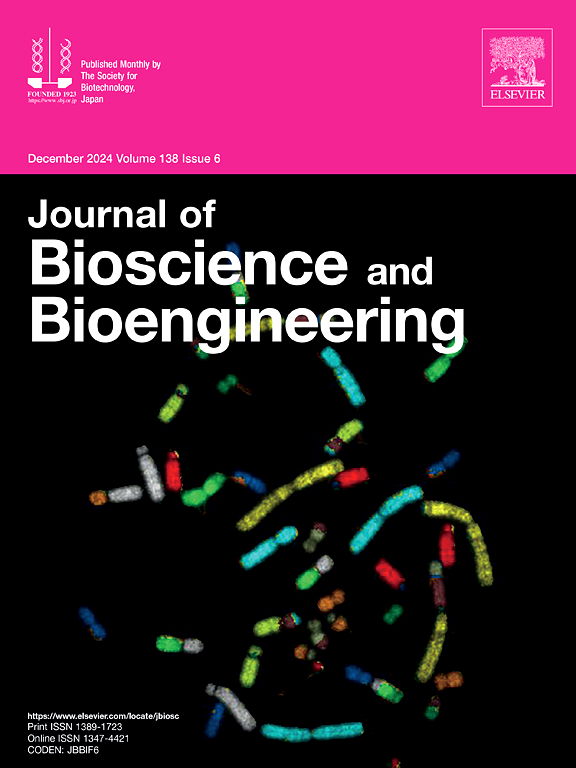系统发育较远的清酒酵母优越发酵性能的基因座异质性机制。
IF 2.9
4区 生物学
Q3 BIOTECHNOLOGY & APPLIED MICROBIOLOGY
引用次数: 0
摘要
从日本清酒发酵罐中分离的酿酒酵母菌,其发酵性能优于其他酵母菌株。尽管现代清酒酵母菌株K701的特殊能力已被广泛研究,但那些在系统发育上遥远的经典清酒酵母菌仍在很大程度上未得到充分研究。本研究旨在通过比较清酒经典酵母菌Km67与实验室菌株X2180和K701的遗传和生理特性,阐明其优越发酵能力的机制。Km67在清酒中没有表现出与K701相同的安静特异性表型。RNA测序结果显示,清酒醪中Km67和K701的转录组具有相似的变化趋势,提示Km67缺乏静息入口与Km67较高的发酵能力有关。基因检测表明,上游的Rim15p信号没有向下游传递,表明在Km67细胞中,Rim15p介导的发酵抑制受损。在Rim15p下游缺失CDC55后,蛋白磷酸酶2A (PP2AB55δ)活性下降,从而降低了Km67的发酵性能。然而,CDC55缺失后发酵还原的程度不如X2180和K701。这表明在Km67中存在不依赖于PP2AB55δ或Rim15p而独立调节发酵的未知因素。因此,我们的研究结果表明,在系统发育上遥远的清酒酵母Km67和K701之间,发酵能力的机制存在基因座异质性。本文章由计算机程序翻译,如有差异,请以英文原文为准。
Locus heterogeneity in the mechanism underlying the superior fermentation performances of phylogenetically distant sake yeasts
Sake yeasts, Saccharomyces cerevisiae strains isolated from Japanese sake fermentation tanks, exhibit superior fermentation performance to that of other yeast strains. Although the exceptional abilities of the modern sake yeast strain K701 have been extensively investigated, those of phylogenetically distant classical sake yeasts remain largely understudied. In this study, we aimed to clarify the mechanism underlying the superior fermentation ability of the classical sake yeast strain Km67 by comparing its genetic and physiological properties with those of the laboratory strains X2180 and K701. Km67 did not exhibit quiescence-specific phenotypes in sake mashes in the same manner as K701. RNA sequencing revealed similar trends between the transcriptomes of Km67 and K701 in sake mash, suggesting that the lack of quiescence entry was related to the higher fermentation ability of Km67. Genetic testing demonstrated that signals upstream of Rim15p were not conveyed downstream, indicating impaired fermentation repression mediated by Rim15p in Km67 cells. Protein phosphatase 2A (PP2AB55δ) activity declined following CDC55 deletion downstream of Rim15p, consequently reducing the fermentation performance of Km67. However, the extent of fermentation reduction upon CDC55 deletion was not as large as that with X2180 and K701. This suggested the presence of unidentified factors that regulated fermentation independently of PP2AB55δ or Rim15p in Km67. Thus, our findings demonstrate locus heterogeneity in the mechanism underlying fermentation abilities between the phylogenetically distant sake yeasts Km67 and K701.
求助全文
通过发布文献求助,成功后即可免费获取论文全文。
去求助
来源期刊

Journal of bioscience and bioengineering
生物-生物工程与应用微生物
CiteScore
5.90
自引率
3.60%
发文量
144
审稿时长
51 days
期刊介绍:
The Journal of Bioscience and Bioengineering is a research journal publishing original full-length research papers, reviews, and Letters to the Editor. The Journal is devoted to the advancement and dissemination of knowledge concerning fermentation technology, biochemical engineering, food technology and microbiology.
 求助内容:
求助内容: 应助结果提醒方式:
应助结果提醒方式:


